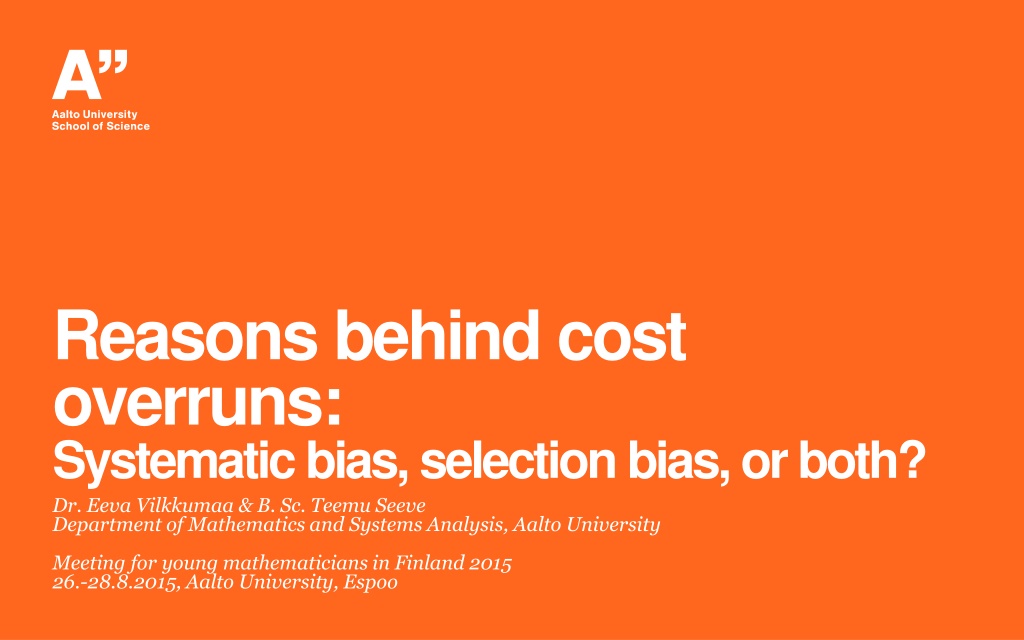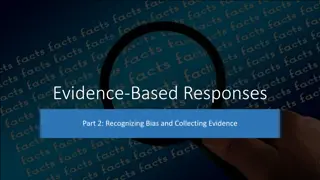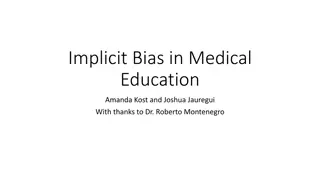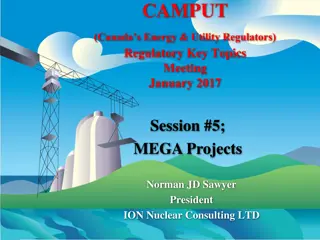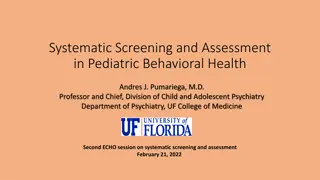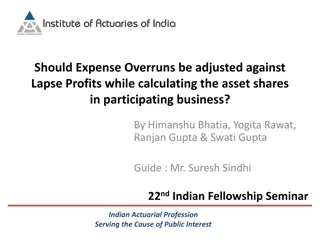Understanding Cost Overruns in Projects: Systematic Bias vs. Selection Bias
Cost overruns in projects can be attributed to systematic bias, like optimism bias and strategic misrepresentation, or selection bias where projects with low estimated costs are more likely to be selected leading to underestimation. Mitigating these biases is crucial for accurate project budgeting and management.
Download Presentation

Please find below an Image/Link to download the presentation.
The content on the website is provided AS IS for your information and personal use only. It may not be sold, licensed, or shared on other websites without obtaining consent from the author. Download presentation by click this link. If you encounter any issues during the download, it is possible that the publisher has removed the file from their server.
E N D
Presentation Transcript
Reasons behind cost overruns: Systematic bias, selection bias, or both? Dr. Eeva Vilkkumaa & B. Sc. Teemu Seeve Department of Mathematics and Systems Analysis, Aalto University Meeting for young mathematicians in Finland 2015 26.-28.8.2015, Aalto University, Espoo
Cost overruns Olkiluoto nuclear reactor: Estimate in 2007: 3.2 billion Estimate now: 8.5 billion Cost overrun: 166% Metro line Ruoholahti-Matinkyl : Estimate in 2004: 452 million Estimate in 2008: 714 million Final estimate: 1.008 billion Cost overrun: 121% 15.11.2024 2
Cost overruns Large transportation infrastructure projects, N=258 Small public works projects, N=1093 Average overrun 27.6% Average overrun 8.33% Source: Bucciol et al. (2011), Cost overrun and auction format in public works, Working Paper Series, WP 17, Department of Economics, University of Verona. Source: Flyvbjerg et al. (2002), Underestimating costs in public work projects error or lie? Journal of the American Planning Association, Vol. 68, pp. 279-295. 15.11.2024 3
Systematic bias Cost overruns are often attributed to a systematic bias in the projects cost estimates, such as: Optimism bias: most people have a cognitive predisposition to judge future events in a more positive light than is warranted by actual experience Strategic misrepresentation: project promoters deliberately and strategically overestimate benefits and underestimate costs to increase the likelihood that their project gets funded 15.11.2024 4
Selection bias Cost estimates of project proposals are always uncertain Some costs have been underestimated, some overestimated There may not be a systematic bias in these estimates Upward and downward errors cancel each other out Often only those projects with the lowest estimated costs are selected for implementation The costs of selected projects are more likely to have been underestimated than overestimated cost overruns occur due to selection bias! 15.11.2024 5
Selection bias True cost of each project Distribution of estimation error F F E E E D C B A F D C B A 15.11.2024 6
Systematic bias vs. selection bias Different biases should be mitigated in different ways How to determine the relative magnitudes of systematic bias and selection bias? How to mitigate these biases? 15.11.2024 7
Model N project proposals i = 1, ,N True costs ci Realizations of ??~????(?,?2) Estimated costs ciE Realizations of (?? ?|??= ??) = ???,where ?~???? ?,?2 Projects i = 1, ,M N with the lowest estimates ciE are selected 15.11.2024 8
Debiasing cost estimates If ? +?2 estimates ciE: 2< 0, then there is a systematic downward bias in cost ???= ?? = ?[ ?]??= exp ? +?2 ? ?? ??< ?? 2 If ? and ?2were known, cost estimates could be debiased through: ?? ?= exp ? ?2 ? ?? 2 ???= ?? = exp ? ?2 ? ?? ?[ ?]??= ?? 2 15.11.2024 9
Biases Total bias (TB): total cost overrun ??? ??? ?=1 ?=1 ?? = ? 1 Selection bias (SeB): cost overrun using debiased estimates ??? ?=1 ? ??? = ? 1 ?? ?=1 Systematic bias (SyB): bias that cannot be eliminated by debiasing estimates ??? = ?? ??? 15.11.2024 10
Estimation of model parameters Following from our distribution assumptions: ? ? + ?,?2 ?2 ?) = ? (ln ??,ln ?? ?2 ?2+ ?2 Parameters ?,?,?,? could be estimated from a random sample of observed pairs (ln ??,ln?? ?) using Maximum Likelihood methods Problem: ln ??are only observed for i = 1, ,M corresponding to the lowest values of ln?? random sample ? M observed pairs do not represent a 15.11.2024 11
Example N = 30 project proposals M = 20 selected projects True parameter values: (?,?,?2,?2) = (6.88, 0.075, 0.065, 0.0375) 15.11.2024 12
Maximum likelihood estimates Parameter Estimated True 7.5 Selected Not selected 6.73 6.88 ? -0.1203 -0.075 ? 7 0.0375 0.065 ?2 E ln ci 0.0318 0.0375 ?2 TB 12.9% 12.9% 6.5 SeB 1.7%-points 6.7%-points SyB 11.2%-points 6.2%-points 6 6.2 6.4 6.6 6.8 7 7.2 7.4 7.6 7.8 8 ln ci 15.11.2024 13
Expectation Maximization algorithm Initialize: ? = [ ?, ?, ?, ?]. 1. ?,ln ?? ? Expectation step: Compute the expected values ? ln ?? of the missing data ln ??, i = M+1, ,N. 2. Maximization step: Obtain a new Maximum Likelihood estimate for ? using data (ln ??,ln?? are the expected values from step 2. 3. ?), i = 1, ,N, where ln ?? for i = M+1, ,N 4. Repeat steps 2 and 3 until some stopping criterion is reached. 15.11.2024 14
Expectation Maximization algorithm Iteration 1 Selected Not selected Expected 7.5 Iteration 2 Selected Not selected Expected 7.5 7 7 E E ln ci ln ci Iteration 1 Iteration 2 6.5 6.5 6 6 6.2 6.4 6.6 6.8 7 7.2 7.4 7.6 7.8 8 6.2 6.4 6.6 6.8 7 7.2 7.4 7.6 7.8 8 ln ci ln ci 7.5 Iteration 3 Selected Not selected Expected Iteration 10 Selected Not selected Expected 7.5 7 7 E E ln ci ln ci Iteration 3 Iteration 10 6.5 6.5 15.11.2024 15 6 6 6.2 6.4 6.6 6.8 7 7.2 7.4 7.6 7.8 8 6.2 6.4 6.6 6.8 7 7.2 7.4 7.6 7.8 8 ln ci ln ci
Expectation Maximization algorithm Parameter Estimated True value 6.85 6.88 ? -0.071 -0.075 ? 0.062 0.065 ?2 0.0264 0.0375 ?2 TB 12.9% 12.9% SeB 6.6%-points 6.7%-points SyB 6.3%-points 6.2%-points 15.11.2024 16
Simulation results Expected values of parameter estimates for different N and P=M/N 15.11.2024 17
Simulation results Expected biases for different values of N, given P=M/N=30% 15.11.2024 19
Simulation results Expected biases for different values of P, given N = 150 15.11.2024 20
Mitigation of biases Systematic bias can be eliminated by debiasing the estimates: ?= exp ? ?2 ?? ? ?? 2 Expected selection bias can be eliminated by adjusting the debiased estimates: ?2 ?2 ?[??| ?= ?] = ( ?) ?2+?2exp ?2+ ? ?2+?2 ?? ?? ?? 15.11.2024 21
Conclusions Cost overruns can result from Systematic bias in the projects cost estimates Selection bias: the costs of the selected projects are more likely to have been underestimated We build a model to Determine the relative magnitudes of the two biases Mitigate both biases The parameters of this model can be estimated using an Expectation Maximization algorithm 15.11.2024 22
